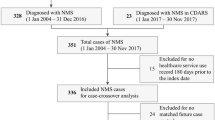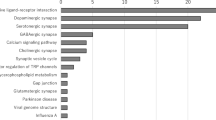Abstract
Neuroleptic malignant syndrome (NMS) is a rare, but severe adverse drug reaction of drugs with anti-dopaminergic properties. The main symptoms are fever and rigor. In addition, other symptoms such as creatine kinase elevation, alteration of consciousness and various neurological symptoms may occur. A total of 52 NMS cases have been documented in the drug safety program ‘Arzneimittelsicherheit in der Psychiatrie’ from 1993 to 2015. We calculated incidences and analyzed imputed substances and additional risk factors to study the impact of changing therapy regimes. The overall incidence was 0.16‰. High-potency first-generation antipsychotics (FGAs) had the highest incidences, e.g. flupentixol with 0.61‰. Second-generation antipsychotics (SGAs) had lower incidences. Low-potency FGAs had very low incidences, comparable to SGAs, but in contrast to SGAs, had not been imputed alone in any case of NMS. Preexisting organic pathologies of the central nervous system, lithium treatment, infection/exsiccosis and the withdrawal of medication with anticholinergic properties or alcohol were found to be additional risk factors. With the increasing use of SGAs, one should always be aware of the risk of NMS. Better suited diagnostic criteria for ‘atypical NMS’ would lead to a better understanding and, therefore, to improved treatment possibilities.


Similar content being viewed by others
References
Addonizio G, Susman VL, Roth SD (1987) Neuroleptic malignant syndrome: review and analysis of 115 cases. Biol Psychiatry 22(8):1004–1020
American Psychiatric Association (2000) Diagnostic and statistical manual of mental disorders DSM-IV-TR. Jaypee Medical Ltd, London
American Psychiatric Association (2013) Diagnostic and statistical manual of mental disorders DSM 5, 5 edn. American Psychiatric Association, London
Belvederi Murri M, Guaglianone A, Bugliani M, Calcagno P, Respino M, Serafini G et al (2015) Second-generation antipsychotics and neuroleptic malignant syndrome: systematic review and case report analysis. Drugs RD 15:45–62. https://doi.org/10.1007/s40268-014-0078-0
Bschor T, Bauer M (1998) Thyroid gland function in lithium treatment. Nervenarzt 69:189–195
Buzan B (1996) Risperidone-induced tardive dyskinesia. Am J Psychiatry 153(5):734–735
Byrd C (1993) Neuroleptic malignat syndrome: a dangerous complication of neuroleptic therapy. J Neurosci Nurs 25(1):62–65
Caroff SN, Mann SC, Campbell EC, Sullivan KA (2002) Movement disorders associated with atypical antipsychotic drugs. J Clin Psychiatry 63(Suppl 4):12–19
Chen Y, Guo JJ, Steinbuch M, Buckley PF, Patel NC (2009) Risk of neuroleptic malignant syndrome in patients with bipolar disorder: a retrospective, population-based case-control study. Int J Psychiatry Med 39:439–450
Fallgatter AJ, Strik WK (1997) Reversible neuropsychiatric side effects of lithium with normal serum levels. A case report. Nervenarzt 68:586–590
Friedrich ME, Akimova E, Huf W, Konstantinidis A, Papageorgiou K, Winkler D, Toto S, Greil W, Grohmann R, Kasper S (2016) Drug-induced liver injury during antidepressant treatment: results of AMSP, a drug surveillance program. Int J Neuropsychopharmacol 19(4):1–9. https://doi.org/10.1093/ijnp/pyv126
Grohmann R, Engel RR, Möller H-J, Rüther E, van der Velden JW, Stübner S (2013) Flupentixol use and adverse reactions in comparison with other common first- and second-generation antipsychotics: data from the AMSP study. Eur Arch Psychiatry Clin Neurosci 264(2):131–141. https://doi.org/10.1007/s00406-013-0419-y
Grohmann R, Engel RR, Ruther E, Hippius H (2004) The AMSP drug safety program: methods and global results. Pharmacopsychiatry 37(Suppl 1):S4–S11. https://doi.org/10.1055/s-2004-815505
Gurrera RJ (2017) A systematic review of sex and age factors in neuroleptic malignant syndrome diagnosis frequency. Acta Psychiatr Scand May 135(5):398–408
Kato D, Kawanishi C, Kishida I, Furuno T, Suzuki K, Onishi H, Hirayasu Y (2007) Effects of CYP2D6 polymorphisms on neuroleptic malignant syndrome. Eur J Clin Pharmacol 63(11):991–996
Keck PE, Pope HG, McElroy SL (1991) Declining frequency of neuroleptic malignant syndrome in a hospital population. Am J Psychiatry 148:880–882. https://doi.org/10.1176/ajp.148.7.880
Keck PE, Pope HG, McElroy SL (1987) Frequency and presentation of neuroleptic malignant syndrome: a prospective study. Am J Psychiatry 144:1344–1346. https://doi.org/10.1176/ajp.144.10.1344
Keck PE, Sebastianelli J, Pope HG, McElroy SL (1989) Frequency and presentation of neuroleptic malignant syndrome in a state psychiatric hospital. J Clin Psychiatry 50:352–355
Lannas PA, Pachar JV (1993) A fatal case of neuroleptic malignant syndrome. Med Sci Law 33(1):86–88
Letmaier M, Grohmann R, Kren C, Toto S, Bleich S, Engel R, Gary T, Papageorgiou K, Konstantinidis A, Holl KA, Painold A, Kasper S (2018) Venous thromboembolism during treatment with antipsychotics—results of a drug surveillance program. World J Biol Psychiatry 19(3):175–186. https://doi.org/10.1080/15622975.2017.1285048
Masi G, Milone A, Viglione V, Mancini A, Pisano S (2014) Massive asymptomatic creatine kinase elevation in youth during antipsychotic drug treatment: case reports and critical review of the literature. J Child Adolesc Psychopharmacol 24:536–542. https://doi.org/10.1089/cap.2014.0047
Meisenzahl EM, Schmitt G, Gründer G, Dresel S, Frodl T, la Fougère C et al (2008) Striatal D2/D3 receptor occupancy, clinical response and side effects with amisulpride: an iodine-123-iodobenzamide SPET study. Pharmacopsychiatry 41:169–175. https://doi.org/10.1055/s-2008-1076727
Moore AP, Macfarlane IA, Blumhardt LD (1990) Neuroleptic malignant syndrome and hypothyroidism. J Neurol Neurosurg Psychiatry 53:517–518
Nagel M, Freisberg S, Junghanns K, Moll CKE, Willenborg B (2015) The neuroleptic malignant syndrome]. Fortschr Neurol Psychiatr 83:373–380. https://doi.org/10.1055/s-0035-1553246
Nielsen RE, Wallenstein Jensen SO, Nielsen J (2012) Neuroleptic malignant syndrome-an 11-year longitudinal case-control study. Can J Psychiatry 57:512–518. https://doi.org/10.1177/070674371205700810
Oruch R, Pryme IF, Engelsen BA, Lund A (2017) Neuroleptic malignant syndrome: an easily overlooked neurologic emergency. Neuropsychiatr Dis Treat 13:161–175
Picard LS, Lindsay S, Strawn JR, Kaneria RM, Patel NC, Keck PE (2008) Atypical neuroleptic malignant syndrome: diagnostic controversies and considerations. Pharmacotherapy 28:530–535. https://doi.org/10.1592/phco.28.4.530
Perrault G, Depoortere R, Morel E, Sanger DJ, Scatton B (1997) Psychopharmacological profile of amisulpride: an antipsychotic drug with presynaptic D2/D3 dopamine receptor antagonist activity and limbic selectivity. J Pharmacol Exp Ther 280:73–82
Pileggi DJ, Cook AM (2016) Neuroleptic malignant syndrome. Ann Pharmacother 50:973–981. https://doi.org/10.1177/1060028016657553
Spindelegger CJ, Papageorgiou K, Grohmann R, Engel R, Greil W, Konstantinidis A et al (2014) Cardiovascular adverse reactions during antidepressant treatment: a drug surveillance report of German-speaking countries between 1993 and 2010. Int J Neuropsychopharmacol 18(4):1. https://doi.org/10.1093/ijnp/pyu080
Spivak B, Gonen N, Mester R, Averbuch E, Adlersberg S, Weizman A (1996) Neuroleptic malignant syndrome associated with abrupt withdrawal of anticholinergic agents. Int Clin Psychopharmacol 11(3):207–209
Spivak B, Maline DI, Kozyrev VN, Mester R, Neduva SA, Ravilov RS et al (2000) Frequency of neuroleptic malignant syndrome in a large psychiatric hospital in Moscow. Eur Psychiatry 15:330–333
Stübner S, Rustenbeck E, Grohmann R, Wagner G, Engel R, Neundörfer G et al (2004) Severe and uncommon involuntary movement disorders due to psychotropic drugs. Pharmacopsychiatry 37(Suppl 1):S54–S64. https://doi.org/10.1055/s-2004-815511
Susman VL, Addonizio G (1988) Recurrence of neuroleptic malignant syndrome. J Nerv Ment Dis 176:234–241
Su Y-P, Chang C-K, Hayes RD, Harrison S, Lee W, Broadbent M et al (2014) Retrospective chart review on exposure to psychotropic medications associated with neuroleptic malignant syndrome. Acta Psychiatr Scand 130:52–60. https://doi.org/10.1111/acps.12222
Tse L, Barr AM, Scarapicchia V, Vila-Rodriguez F (2015) Neuroleptic malignant syndrome: a review from a clinically oriented perspective. Curr Neuropharmacol 13:395–406
Tseng P-T, Chang Y-C, Chang C-H, Wang H-Y, Cheng Y-S, Wu C-K et al (2015) Atypical neuroleptic malignant syndrome in patients treated with aripiprazole and clozapine: a case-series study and short review. Int J Psychiatry Med 49:35–43. https://doi.org/10.2190/PM.49.1.c
Woodbury MM, Woodbury MA (1992) Neuroleptic-induced catatonia as a stage in the progression toward neuroleptic malignant syndrome. J Am Acad Child Adolesc Psychiatry 31(6):1161–1164
World Health Organisation (WHO) (2016) The international statistical classification of diseases and related health problems, ICD-10 2016 by World Health Organization (WHO) (2015-10-26)
Acknowledgements
This study was supported by the AMSP Drug Safety Programme, Hannover, Germany. The analysis of the NMSdata and this publication were made possible by a grant from Immanuel Klinik Rüdersdorf.
Author information
Authors and Affiliations
Corresponding author
Ethics declarations
Conflict of interest
T. Greiner, M. Schneider, S. Lensky, S. Stübner, J. Regente and M. Heinze declare no conflict of interests. The AMSP Drug Safety Program is based on non-profit associations in the German-speaking countries Germany, Austria and Switzerland. In recent years, financial support has been contributed by almost all the pharmaceutical companies involved in CNS research. Since 1993, educational and research grants have been awarded by the following pharmaceutical companies to the three national non-profit associations of the AMSP. Austrian companies: AstraZeneca Österreich GmbH, Boehringer Ingelheim Austria, Bristol–Myers Squibb GmbH, CSC Pharmaceuticals GmbH, Eli Lilly GmbH, Germania Pharma GmbH, GlaxoSmithKline Pharma GmbH, Janssen-Cilag Pharma GmbH, Lundbeck GmbH, Novartis Pharma GmbH, Pfizer Med Inform, Servier Pharma Austria, Wyeth Lederle Pharma GmbH. German companies: Abbott GmbH & Co. KG, AstraZeneca GmbH, Aventis Pharma Deutschland GmbH GE-O/R/N, Bayer Vital GmbH & Co. KG, Boehringer Mannheim GmbH, Bristol-Myers-Squibb, Ciba Geigy GmbH, Desitin Arzneimittel GmbH, Duphar Pharma GmbH & Co. KG, Eisai GmbH, esparma GmbH Arzneimittel, GlaxoSmithKline Pharma GmbH & Co. KG, Hoffmann-La Roche AG Medical Affairs, Janssen-Cilag GmbH, Janssen Research Foundation, Knoll Deutschland GmbH, Lilly Deutschland GmbH Niederlassung Bad Homburg, Lundbeck GmbH & Co. KG, Nordmark Arzneimittel GmbH, Novartis Pharma GmbH, Organon GmbH, Otsuka-Pharma Frankfurt, Pfizer GmbH, Pharmacia & Upjohn GmbH, Promonta Lundbeck Arzneimittel, Rhone-Poulenc Rohrer, Sanofi-Synthelabo GmbH, Sanofi-Aventis Deutschland, Schering AG, Servier Pharma, SmithKlineBeecham Pharma GmbH, Solvay Arzneimittel GmbH, Synthelabo Arzneimittel GmbH, Dr Wilmar Schwabe GmbH & Co., Thiemann Arzneimittel GmbH, Trommsdorff GmbH & Co. KG Arzneimittel, Troponwerke GmbH & Co. KG, Upjohn GmbH, Wander Pharma GmbH, Wyeth-Pharma GmbH. Swiss companies: AHP (Schweiz) AG, AstraZeneca AG, Bristol–Myers Squibb AG, Desitin Pharma GmbH, Eli Lilly (Suisse) S.A., Essex Chemie AG, GlaxoSmithKline AG, Janssen-Cilag AG, Lundbeck (Suisse) AG, Mepha Schweiz AG/Teva, MSD Merck Sharp & Dohme AG, Organon AG, Pfizer AG, Pharmacia, Sandoz Pharmaceuticals AG, Sanofi-Aventis (Suisse) S.A., Sanofi-Synthe´labo SA, Servier SA, SmithKlineBeecham AG, Solvay Pharma AG, Vifor SA, Wyeth AHP (Suisse) AG, Wyeth Pharmaceuticals AG. S. Bleich, R. Grohmann and S. Toto are project managers of the AMSP program. S. Toto has been a member of the advisory board for Otsouka and has received speaker’s honoria from Janssen-Cilag, Lundbeck, Otsouka and Servier.
Rights and permissions
About this article
Cite this article
Schneider, M., Regente, J., Greiner, T. et al. Neuroleptic malignant syndrome: evaluation of drug safety data from the AMSP program during 1993–2015. Eur Arch Psychiatry Clin Neurosci 270, 23–33 (2020). https://doi.org/10.1007/s00406-018-0959-2
Received:
Accepted:
Published:
Issue Date:
DOI: https://doi.org/10.1007/s00406-018-0959-2




